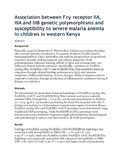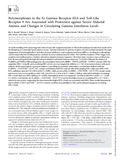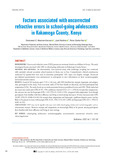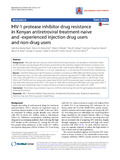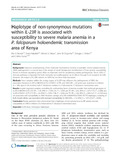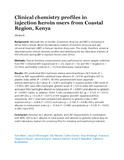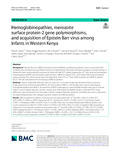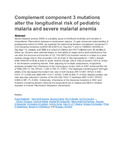Search
Now showing items 1-10 of 31
Association between Fcγ receptor IIA, IIIA and IIIB genetic polymorphisms and susceptibility to severe malaria anemia in children in western Kenya
(BMC Infectious Diseases, 2017-04-20)
Background
Naturally-acquired immunity to Plasmodium falciparum malaria develops after several episodes of infection. Fc gamma receptors (FcγRs) bind to immunoglobulin G (IgG) antibodies and mediate phagocytosis of opsonized ...
Polymorphisms in the Fc Gamma Receptor IIIA and Toll-Like Receptor 9 Are Associated with Protection against Severe Malarial Anemia and Changes in Circulating Gamma Interferon Levels
(ASM Journals, 2012-11-12)
An understanding of the immunogenetic basis of naturally acquired immunity to Plasmodium falciparum infection would aid in the designing of a rationally based malaria vaccine. Variants within the Fc gamma receptors (FcγRs) ...
Nonsynonymous amino acid changes in the α-chain of complement component 5 influence longitudinal susceptibility to Plasmodium falciparum infections and severe malarial anemia in kenyan children
(Frontier in genetics, 2022-08-14)
Background: Severe malarial anemia (SMA; Hb < 5.0 g/dl) is a leading cause of childhood morbidity and mortality in holoendemic Plasmodium falciparum transmission regions such as western Kenya.
Methods: We investigated ...
Entire Expressed Peripheral Blood Transcriptome in Pediatric Severe Malarial Anemia
(Research Square, 2023-06-19)
This study on severe malarial anemia (SMA: Hb < 6.0 g/dL), a leading global cause of childhood morbidity and mortality, analyzed the entire expressed transcriptome in whole blood from children with non-SMA (Hb ≥ 6.0 g/dL, ...
HIV-1 protease inhibitor drug resistance in Kenyan antiretroviral treatment-naive and -experienced injection drug users and non-drug users
(AIDS Research and Therapy, 2015-08-15)
Background
Although injection drug use drives antiretroviral drug resistance, the prevalence of protease inhibitor (PI) resistance among Kenyan IDUs remains undetermined. We, therefore, explored PI resistance mutations ...
Interleukin (IL)-13 promoter polymorphisms (-7402 T/G and -4729G/A) condition susceptibility to pediatric severe malarial anemia but not circulating IL-13 levels
(BMC Immunology, 2013-03-25)
In holoendemic Plasmodium falciparum transmission areas such as western Kenya, severe malarial anemia [SMA, hemoglobin (Hb) < 6.0 g/dL, with any density parasitemia] is the most common clinical manifestation of severe ...
HIV-1 protease inhibitor drug resistance in Kenyan antiretroviral treatment-naive and -experienced injection drug users and non-drug users
(AIDS Research and Therapy, 2015-08-15)
Background
Although injection drug use drives antiretroviral drug resistance, the prevalence of protease inhibitor (PI) resistance among Kenyan IDUs remains undetermined. We, therefore, explored PI resistance mutations ...
Clinical chemistry profiles in injection heroin users from Coastal Region, Kenya
(BMC Clin Pathol, 2014-07-09)
Background: Although the co-burden of injection drug use and HIV is increasing in Africa, little is known about the laboratory markers of injection drug use and anti-retroviral treatment (ART) in Kenyan injection drug ...
Hemoglobinopathies, merozoite surface protein-2 gene polymorphisms, and acquisition of Epstein Barr virus among infants in Western Kenya
(BMC Cancer, 2023-06-20)
Background
Epstein Barr virus (EBV)-associated endemic Burkitt’s Lymphoma pediatric cancer is associated with morbidity and mortality among children resident in holoendemic Plasmodium falciparum regions in western Kenya. ...
Complement component 3 mutations alter the longitudinal risk of pediatric malaria and severe malarial anemia
(Experimental Biology and Medicine, 2021-11-19)
Severe malarial anemia (SMA) is a leading cause of childhood morbidity and mortality in holoendemic Plasmodium falciparum transmission regions. To gain enhanced understanding of predisposing factors for SMA, we explored ...

